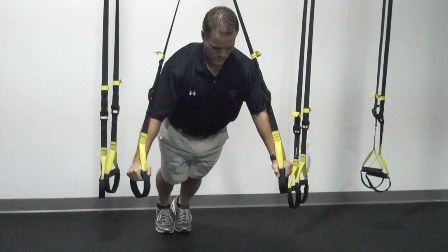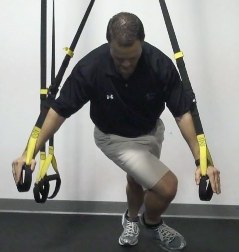
In the third installment of his TRX Suspension Trainer series, Brian demonstrates the 45 Degree Mountain Climbers exercise, which increases scapular stability and reduces the likelihood of imbalances and overuse injuries.
See 'RelatedResources' below for past Functionally Fits (including the TRX miniseries) andother exercises and training tips.
Execution
Begin with both feet together on the floor facing out and away from the anchor point at approximately a 45 degree angle (more upright if needed initially). Prior to initiating movement, actively depress the shoulder blades (push down and slightly inward) while keeping the arms straight. Maintain this depression position at all times, as one of the primary goals of the exercise is improving scapular stability.

Next, lift one knee up, pause and lower down. You may opt to repeat all 10-15 repetitions on the same side at first before alternating sides, or alternate immediately if the client demonstrates good control. I prefer a slower, deliberate motion to keep the focus on maintaining scapular alignment as well as maintaining a neutral spine position throughout.
 |  |
Perform 1-2 sets of 10-15 reps on each side. For more advanced triplanar work, move to a cross mountain climber movement. The set-up is the same, however, now you bring the opposite knee toward the opposite hand. Again, you may opt to repeat all reps on the same side or choose an alternate side approach for added challenge.
 |  |
Application
Many clients and athletes lack sufficient scapular stability, thereby leading to imbalances and overuse injury. Improving scapular depression and downward rotation is important to counteract an overactive upper trap and pec muscle group that may cause undesirable scapular upward rotation, winging and tipping.
Initiating this exercise in a 45 degree position allows you to leverage body weight to create a closed chain environment to reinforce scapular depression/downward rotation while essentially performing core stability work at the same time. This exercise is ideally suited for overhead athletes, gymnasts and clients seeking optimal shoulder health or suffering from scapular dyskinesia and/or a faulty scapula-humeral rhythm.
I typically avoid a fast pace, as the scapular stability gives way to the overriding need for controlling the body perturbation and higher risk of loss of balance. While the exercise may seem straightforward, clients often struggle to maintain a neutral body position. The cross over climber is an excellent way to train the shoulders and obliques simultaneously.
To further increase the difficulty, simply instruct your clients to position themselves closer to the anchor point, thereby lowering the angle and placing the shoulder axis at or near the anchor.
Precautions
This exercise requires a certain prerequesite amount of upper body strength, body control and understanding and/or familiarity with the TRX to be successful. I suggest spotting your clients initially by standing in front of them to prevent a sudden fall or unexpected loss of balance. You may even opt to work on static active scapular depression without the mountain climber at first. Clients with known posterior or multi-directional shoulder instability should be advised to remain more upright and progress with caution to ensure they can stabilize the shoulder as fatigue sets in.
















